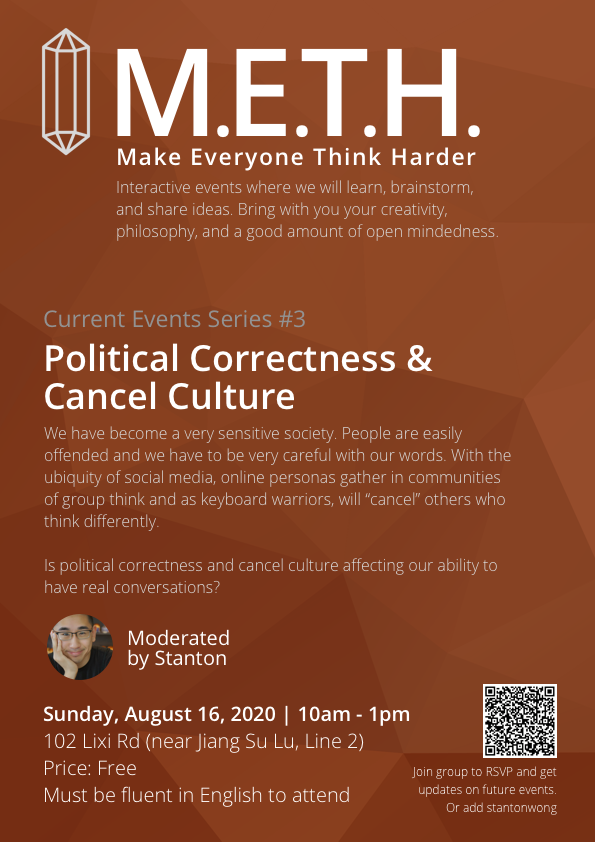The third METH event was in mid August. The topic was “Political Correctness + Cancel Culture”. The intention was to connect technology with political correctness, which has created cancel culture, but most of the time was spent defining and exploring political correctness as a concept and as a term.

What I’ll be writing is based on the notes from the conversations that we had, so the content and logic might jump around a little. Note that this does not directly reflect my opinion, but there are interesting ideas in here that might provide valuable content to help Make Everyone Think Harder.
1. What is Political Correctness? What is Cancel Culture?
We started the session exploring what Political Correctness (often referred to as PC) and Cancel Culture is. The reason I chose to put these two together is because I think they are very relevant with each other, with cancel culture being a recent manifestation of political correctness thanks to the conveniences of technology access and social media.
Let’s start with a dictionary definition. According to Oxford, political correctness is “the avoidance, often considered as taken to extremes, of forms of expression or action that are perceived to exclude, marginalize, or insult groups of people who are socially disadvantaged or discriminated against.”
Some connotations of the term, political correctness, that were shared is that it is most applicable to smaller groups or minorities and that it is often used to define and express what is and what is not acceptable in terms of social norms.
As for Cancel Culture, it is a much newer term for online shaming and according to Wikipedia, it can be defined as “the practice of withdrawing support for (or canceling) public figures and companies after they have done or said something considered objectionable or offensive”. Essentially, it is a collective expression of the masses to showcase that they are unhappy or in disagreement with someone else’s opinion.
2. Why is Political Correctness and Cancel Culture a thing?
So why is political correctness a thing? One reason is for setting boundaries as a form of social self defense. Political correctness allows people to create boundaries around topics that are offensive to them. It allows them to label people as others if they are disagreeing with their point of view and also to unify others who are of the same opinion and view point. And gradually, as it nears critical mass, we are looking at groups of people perhaps forming an identity around certain opinions on subjects.
The most popular and obvious example of this is in racism. In North America, the word, nigger, is off limits to everyone except for black people, to the point that if I wanted to be PC, I’m probably supposed to write it as if I’m swearing, like this: n*gger. No specifics on where the black person is from, just that anybody without black skin should not use this word. The word has been made into an identity to differentiate themselves from insiders and outsiders. It is only PC for insiders to use the word. For everyone else, it is offensive. Other examples include gender, industry, body shaming, etc.
A question that was brought up is that is this a specific phenomenon in North America or do a lot of minorities that have been subjugated at one point in time in history also do something similar?
Another reason for the gradual increase in political correctness is sensitivity. Our society is becoming a society of snowflakes (people who are easily offended) because we have created environments where we do not build resilience. People are challenged less often because upon hitting a wall, there is always a crevice somewhere that will align with your ideals already, so you congregate with these people instead of challenging your ideals. As a society, we are becoming too sensitive because we have created an environment that protects sensitive people and PC is an additional tool that can be used to call someone out for offending you.
Which leads us into cancel culture. Cancel Culture became a thing because it is very easy to say things online. Being semi-anonymous without direct and face-to-face repercussions allows people to express a less filtered side of themselves. There just isn’t as much accountability on social platforms.
Additionally, cancel culture allows individuals to assert dominance. A lot of people have a lack of power in daily life. They feel stuck and feel like they are effectively neutered with no control over their professional and personal life and there is a lack of confidence to fight against this lack of power. Participating in cancel culture allows them to part of something where minimal effort can have a dominating effect on someone else. It gives them the illusion of power and it is intoxicating. Cancel culture is the culmination of lazy thinking, where people don’t have to think hard and can follow along with the masses (the opposite of what we are doing here with METH), and the ability to maximize an individual’s impact by co-opting the conversation.
So, is there a good side and a bad side to being PC?
3. What is good PC? What is bad PC?
Some of the good things about being PC is that it helps set rules that make a certain group of people feel good, limits their discomfort, and generally makes it easier to maintain social norms by establishing the rules that clarify and remove the potential of embarrassment in public for the purposes of comfort. It cultivates harmony in a society and generally informs people on how to not be a jerk.
Some of the bad things about being PC is that it ignore’s different people’s ideas and shuts down dialogue. Cancel culture is an example that uses technology to shut down people who have ideas that differ from ours. This is a big issue from a society’s perspective because it limits intellectual exploration. PC culture also limits creativity and prevents self reflection and discovery because a lot of people are given containers and molds that they need to fit into. There is a huge risk for many people to change ideologies or to explore and embrace other ideas.
To take this a step further, most of the global society has a culture around money. PC is now used as a part of a company’s public relations strategy, to make a company align and seem good in the eyes of consumers.
From a more philosophical perspective, what is good and what is bad is highly subjective and based on context. Is good and bad defined by god, by society, or by individuals? Or does it just have to be generally accepted by a certain majority? A great question that was asked is whether or not a political correctness culture is political correct in itself or not?
An interesting point that was brought up is that cancel culture is an act of implementing political correctness online from an individual perspective in a grassroots approach. It is the opposite of institutional political correctness, where an established power states whether something is politically correct or not. For example, certain government parties stating how it is offensive to attack certain groups of people for supporting their ideology would be an institutional use of political correctness.
Another interesting point is the public and private dichotomy. In private conversations, most people are much less PC. They can speak their mind and not worry about the repercussions because it is severely localized to the few people listening to their conversations. But nowadays, the private and public is merging, with many people not understanding the difference when posting on social media. Bringing the private into the public requires significantly more consideration in regards to the language and content that is expressed if someone wants to conform.
4. What is the future of political correctness?
The general conclusion we came to is that political correctness is a way to establish and use power. The good aspects of PC is representative of a shield while the bad aspects of PC is representative of a sword or a weapon. One is used to defend and the other is use to attack. Therefore, political correctness is not necessarily a culture, but a tool to be used to grab and control power.
Our group leaned more towards the negatives of political correctness, on how it is stopping conversations, can make people faker, and it is generally a lazy way for most people to seek consensus without respecting that diversity and complexity is the essence of human society. Additionally, in the future, conversations around Political Correctness will move increasingly from offline to online, extend increasingly beyond national borders, and be increasingly weaponized to motivate political change.
Education is going to play a very important part in improving the situation, which is in desperate need of refreshing to accommodate the issues and interactions that we encounter in the 21st century. There needs to be more education around communication and empathy, connecting with different people and cultures, especially those that think differently from you. Most cultures around the world inherently have different acceptance levels and understanding of PC culture. Education includes the mass media, which plays a big role in exacerbating this if they play a role in isolating people into certain identities and limit the ability for people to think harder.
Lastly, we believe that the term, “Political Correctness”, is outdated. Most of the correctness nowadays does not relate to politics, but are more about social issues. We should call it “Social Correctness” instead.
What is M.E.T.H.?
M.E.T.H. (Make Everyone Think Harder) are interactive events where participants learn, brainstorm, and share ideas. Participants need to bring with them their creativity, philosophy, and a good amount of open mindedness.
The events are designed to be slightly uncomfortable and touch on potentially sensitive topics with the goal of bringing out opposing view points, thoughts, and ideas.
Events are currently being run in Shanghai.
